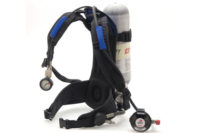
Proper personal protection gear — gloves, helmets and eye shields — guard against obvious welding dangers such as skin burns, eye damage and electric shock. But these pieces of equipment are only part of the personal protection equation for welders. Often missing is respiratory protection, due to a misunderstanding of the environmental hazards and respiratory damage that can be caused by hazardous welding fumes.
Proper respiratory protection presents challenges for welders. It’s difficult to know what level of protection is needed for each unique application. Each requires understanding potential hazards and the methods available to remove them, or in the case of hexavalent chromium, to protect against them.
Dangers of hex chrome
Hexavalent chromium is a hazard that has brought new focus to respiratory protection for welders. According to OSHA, inhaling high levels of hexavalent chromium can cause irritation to the nose and throat. Symptoms may include runny nose, sneezing, coughing, itching and a burning sensation. Repeated or prolonged exposure can cause sores to develop in the nose and result in nosebleeds. If the damage is severe enough, the nasal septum may develop a hole or perforation.
While breathing small amounts of hexavalent chromium does not always cause respiratory tract irritation, long-term, repeated use in applications such as welding can cause damage to skin and eyes if workers are exposed to substantial concentrations. Some employees become allergic to hexavalent chromium so that inhaling chromate compounds can cause asthma symptoms such as wheezing and shortness of breath. Workers cutting or welding stainless steel or other chromeplated metals are at risk of inhaling fumes containing hex chrome. Welding in enclosed areas with poor ventilation or in confined spaces increases the risks to the welder.
Welding in confined areas
Welding in confined spaces requires proper safety procedures to be followed to ensure worker safety, including proper ventilation, constant monitoring of all potential hazards, and the use of appropriate and proper personal protective equipment (PPE), including respiratory protection. Before entry, a confined space should be monitored for all hazardous gases, but at a minimum for the presence of carbon monoxide, hydrogen sulfide, combustible gases or low levels of oxygen. The confined space should also be properly ventilated to lower hazard levels as much as possible. Always ensure that the proper attendants are present and rescue equipment in place before making any confined space entry.
If the confined space is — or is potentially — Immediately Dangerous to Life and Health (IDLH), the worker must wear a tight-fitting air-supplied respirator, either a NIOSH-approved self-contained breathing apparatus (SCBA) or supplied-air respirator (SAR) with escape cylinder. Both respirators are available with tightfitting facepieces that offer proper welding protection.
A traditional SCBA provides the welder with up to 60 minutes of Grade D breathing air via a cylinder worn on the welder’s back. A less common option is a closedcircuit SCBA, or CCBA. A closed-circuit unit filters the worker’s exhaled air and introduces oxygen to the breathing loop to provide the worker with breathable air. This option is ideal for long-duration applications — the unit can provide air for up to four hours.
Supplied-air respirators (SAR) provide the welder with a constant flow of Grade D breathing air delivered via a supplied airline connected to the welder at all times. The air can be provided from a bank of breathing air cylinders, a breathing air compressor, or filtered air from an industrial air compressor utilizing a breather box or a portable air cart containing breathing air cylinders. The duration of a supplied-air respirator is only limited to the capacity of the supplied air source. Because of the design of extended duration airlines, the possibility of the air source being interrupted requires that all supplied-air respirators used in IDLH situations include an escape cylinder providing enough Grade D breathing air to escape the environment.
Protection for other applications
For welding operations not being done in a confined space or IDLH environment below the OSHA PEL, proper respiratory protection using an air-purifying respirator (APR) or a powered air-purifying respirator (PAPR), may be used. Tight-fitting, full face welding respirators will always offer a higher level of protection versus a half-mask respirator or loose-fitting hood and, in some cases, the same facepiece used on the air-supplied respirator can also be used for APR and PAPR applications.
Particulate filtration on an APR or PAPR will sufficiently protect the welder from hex chrome fumes if concentrations are low enough. There may be additional respiratory hazards in the welding environment other than the hex chrome fumes. Once additional hazards are recognized, measured and confirmed to be at acceptable levels for APR or PAPR protection, choose the proper cartridge or canister style to protect against the hazards. Cartridges and canisters for APR and PAPR are available in particulate-only, straight gas and combination configurations. Particulate protection will be necessary to protect against hex chrome fumes, but if other gas hazards are present, it will be best to choose the proper combination cartridge or canister to protect against the additional hazards.
Compliance and assessment
It is vitally important for welders to follow all safety guidelines and rules set forth by their employer and OSHA. Amended OSHA standards for chromium are 1910.1026 (General Industry), 1915.1026 (shipyards, marine terminals and longshoring) and 1926.1126 (Construction). These OSHA standards lower the PEL to 5 micrograms/m3. Affected industries must perform hazard assessments and have implemented the new OSHA requirements by May 30, 2007.
It is also important to perform a hazard assessment and either engineer out the hazard or use PPE to protect workers when working in areas above the new OSHA PEL. If engineering controls are not feasible and it’s not possible to implement engineering controls to eliminate the hex chrome hazard, refer to OSHA’s respiratory protection guidelines.
